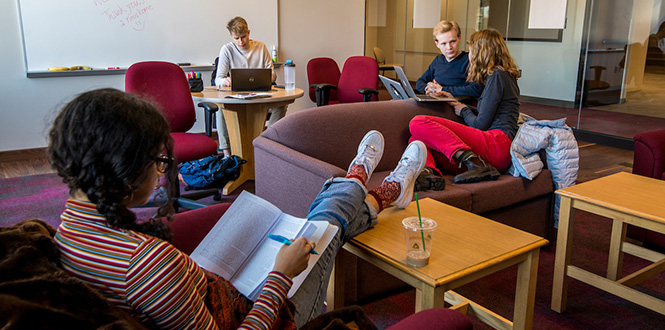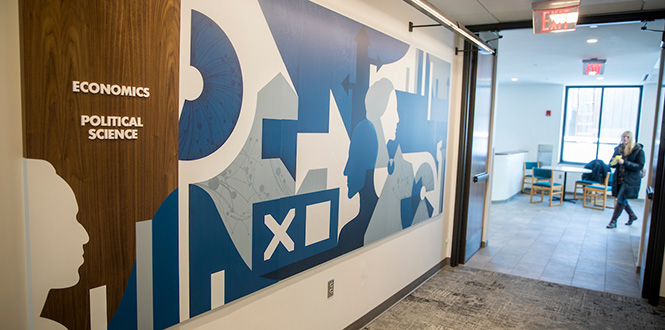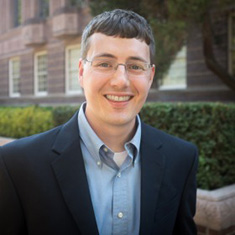HSSC pavilions opening ushers in new era of learning opportunities
Feb. 22, 2019 — For Virginia Haverstic ’21, a French and sociology major from Missouri, the recently opened portion of the Grinnell College Humanities and Social Studies Center (HSSC) is appealing both visually and pragmatically.
“I really like the incorporation of the old Alumni Recitation Hall (ARH) into the atrium,” she says. “I think it’s especially gorgeous and it really preserves the old building while incorporating it into this new space.”
Haverstic has two classes in the HSSC, but like many students, she spends time in the new building doing homework and working in groups.
“It was a struggle in ARH and Carnegie to work with the old computer setups and the TVs,” she says. “Now that there is more technology, classrooms, and common spaces, it’s much easier to find a place to study.”
 Students do homework and collaborate on an assignment in one of the many study spaces inside the HSSC.
Students do homework and collaborate on an assignment in one of the many study spaces inside the HSSC.
Haverstic’s early reviews of the HSSC is likely music to the ears of the many College faculty, staff, administrators, Trustees, and students who spent years contemplating how to bring humanities and social studies departments together in one building to create innovative learning spaces that encourage multi-disciplinary collaboration, active inquiry, student research, and intellectual collisions.
Construction workers are putting the finishing touches on the North and South Pavilions and the central three-story atrium. Most sections of the two pavilions are open, and spring classes are well underway. Next up in the project is the renovations and preservation of ARH and Carnegie Hall with scheduled completion in March 2020.
The entire HSSC encompasses three stories and 200,799 square feet, including the 147,539-square-foot addition. The project started in January 2017. Faculty began to move their offices into the new building this January.
“After six years of planning, design and construction it is thrilling to see our dreams materialized with spectacular new classrooms, students interacting with one another and faculty members interacting across disciplines as they are in neighborhoods mixed together,” Jim Swartz, Dack professor of chemistry and co-chair of the College’s Building Advisory Committee, said last month.
 The economics and political sciences departments are integrated in one of the South Pavilion academic neighborhoods.
The economics and political sciences departments are integrated in one of the South Pavilion academic neighborhoods.
The academic neighborhoods are sprinkled throughout the HSSC conjoining disciplines.
“One of the things we’ve talked about in economics is developing a sense of community within the major,” says Logan Lee, an assistant professor in economics. “Now we have spaces where that is more easily facilitated. Economic majors can meet fellow economic majors as well as political science majors since we are integrated.”
 Logan Lee, assistant professor
Logan Lee, assistant professor
in economics
Lee says there’s a lot to be gained by him having formal and informal discussions with political scientists.
“Often times, you end up talking to the people you are around,” Lee says. “So that drives you to interact with people outside your normal sphere. If I have questions for a class or research, I can just go down the hall and talk to a political scientist.”
Beyond classrooms and faculty offices, the HSSC also will soon be the new home to the Institute for Global Engagement, the Center for Teaching, Learning, and Assessment; and the Data Analysis and Social Inquiry Lab (DASIL). A redesigned auditorium, large multipurpose room and atrium coffee bar also are in the works.
Students are already taking advantage of academic commons, student research rooms, team rooms, and 39 technology-enriched classrooms. In the first week the HSSC was open, Swartz said he was struck with how many student groups were already using the pavilions as gathering spots.
Steven McDowell ’21, a political science major, says the HSSC is his new go-to study space.
“It’s nice that there’s a lot more places to study,” he says. “In the Noyce Science Center, it’s tough to find space because every classroom and study area are usually taken. When it’s completely done, the HSSC is going to be the most attractive building on campus in my opinion. It has this modern feel. I love the glass throughout the building.”
McDowell is taking a class this semester in the HSSC about the presidency. Projectors are frequently used during class and there are TVs in the back of the room that show the same thing as what is being projected to the front in the room, making it easy for students and the professor to see the screens. The ample room and moveable furniture further amplify how the teaching dynamic has changed in the 21st century, from less lecturing to a more dialogic concept of teaching and learning.
Though packed with snow at the moment, four outdoor teaching spaces will be added in coming months. The spaces will be accessible, have technological capabilities, and are designed with sound configurations in mind so that audible disruptions will be kept to a minimum.
The energy-efficient HSSC is designed to utilize only 45 percent of the energy used by a similar-sized building. The facility’s other green features include a heat-reflective roof, energy-efficient LED lighting, and geothermal heating and cooling.
“Overall, the HSSC feels like a modern, cutting-edge, leading facility, which is what Grinnell wants to be,” Lee says. “I think alumni are going to notice that when they step foot in the HSSC.”
—by Jeremy Shapiro
For your information:
HSSC interior and exterior investment opportunities are available at various gift levels. For more information, contact Susan Kriegel, development assistant, at 866-850-1846 or kriegels@grinnell.edu.
To read more alumni news, check out our
news archive.